Engineered Intelligent Electrochemical Biosensors for Portable Point-of-Care Diagnostics
Abstract
1. Introduction
2. Fundamentals of Electrochemical Biosensors
3. Engineered Intelligent Electrochemical Biosensors
3.1. Carbon Material
3.2. Mental-Organic Frameworks (MOFs)
3.3. Hydrogels
4. Electrochemical Biosensors for Biomarker Detection in Early-Stage Disease Diagnostics
4.1. Protein
4.2. Nucleic Acids
4.3. Small Metabolites
5. Trends and Challenges for the Future
Author Contributions
Funding
Conflicts of Interest
References
- Dashtian, K.; Hajat, S.; Karimi, R.; Keyhan, M. Near-Infrared-Responsive Photoelectrochemical Biosensors. Trends Anal. Chem. 2024, 179, 117890. [Google Scholar] [CrossRef]
- Kny, E.; Hasler, R.; Luczak, W.; Knoll, W.; Szunerits, S.; Kleber, C. State of the Art and Future Research Directions of Materials Science Applied to Electrochemical Biosensor Developments. Anal. Bioanal. Chem. 2024, 416, 2247–2259. [Google Scholar] [CrossRef] [PubMed]
- Heydari-Bafrooei, E.; Ensafi, A.A. Nanomaterials-Based Biosensing Strategies for Biomarkers Diagnosis, a Review. Biosens. Bioelectron. X 2023, 13, 100245. [Google Scholar] [CrossRef]
- Chen, Y.; Jiang, H.; Liu, X.; Wang, X. Engineered Electrochemiluminescence Biosensors for Monitoring Heavy Metal Ions: Current Status and Prospects. Biosensors 2024, 14, 9. [Google Scholar] [CrossRef]
- Mehrvar, M.; Abdi, M. Recent Developments, Characteristics, and Potential Applications of Electrochemical Biosensors. Anal. Sci. 2004, 20, 1113–1126. [Google Scholar] [CrossRef]
- Grieshaber, D.; MacKenzie, R.; Vörös, J.; Reimhult, E. Electrochemical Biosensors—Sensor Principles and Architectures. Sensors 2008, 8, 1400–1458. [Google Scholar] [CrossRef]
- Sankar, K.; Kuzmanović, U.; Schaus, S.E.; Galagan, J.E.; Grinstaff, M.W. Strategy, Design, and Fabrication of Electrochemical Biosensors: A Tutorial. ACS Sens. 2024, 9, 2254–2274. [Google Scholar] [CrossRef]
- Suhito, I.R.; Koo, K.M.; Kim, T.H. Recent Advances in Electrochemical Sensors for the Detection of Biomolecules and Whole Cells. Biomedicines 2021, 9, 15. [Google Scholar] [CrossRef]
- Ghormade, P.S.; Kumar, N.B.; Tingne, C.V.; Keoliya, A.N. Distribution & Diagnostic Efficacy of Cardiac Markers Ck-Mb & Ldh in Pericardial Fluid for Postmortem Diagnosis of Ischemic Heart Disease. J. Forensic Leg. Med. 2014, 28, 42–46. [Google Scholar]
- Sarkar, S.; Hazra, S.; Patra, S.; Gogoi, M. Biosensors for Cancer Detection: A Review. TrAC Trends Anal. Chem. 2024, 180, 117978. [Google Scholar] [CrossRef]
- Chen, G.-Y.; Chai, T.-Q.; Zhang, H.; Yang, F.-Q. Applications of Mild-Condition Synthesized Metal Complexes with Enzyme-Like Activity in the Colorimetric and Fluorescence Analysis. Coord. Chem. Rev. 2024, 508, 215761. [Google Scholar] [CrossRef]
- Wu, D.; Tang, D. Recent Advances on Portable Photoelectrochemical Biosensors for Diagnostics. Electroanalysis 2023, 12, 35. [Google Scholar] [CrossRef]
- Barhoum, A.; Altintas, Z.; Devi, K.S.S.; Forster, R.J. Electrochemiluminescence Biosensors for Detection of Cancer Biomarkers in Biofluids: Principles, Opportunities, and Challenges. Nanotoday 2023, 50, 101874. [Google Scholar] [CrossRef]
- Zou, A.; Zhu, X.; Fu, R.; Wang, Z.; Wang, Y.; Ruan, Z.; Xianyu, Y.; Zhang, J. Harnessing Nanomaterials for Next-Generation DNA Methylation Biosensors. Small 2025, 21, 2408246. [Google Scholar] [CrossRef]
- Bhattacharjee, S.; Neppolian, B.; Das, J. Electrochemical Fabrication of Aupt Nanoalloy Embedded Nitrogen-Doped Reduced Graphene Oxide (Aupt@N-Ergo) Based Combinatorial Dual-Analyte Sensor. J. Alloys Compd. 2024, 1004, 175712. [Google Scholar] [CrossRef]
- Boonkaew, S.; Szot-Karpińska, K.; Niedziółka-Jönsson, J.; de Marco, A.; Jönsson-Niedziółka, M. Nfc Smartphone-Based Electrochemical Microfluidic Device Integrated with Nanobody Recognition for C-Reactive Protein. ACS Sens. 2024, 9, 3066–3074. [Google Scholar] [CrossRef]
- Zhang, Z.; Ji, H.; Xu, Y.; Zhuang, X.; Zeng, C.; Liu, J.; Cui, F.; Ding, W.; Zhu, S. Multivalent Acetylated-Sialic Acid as Recognition Elements for the Electrochemical Sensing of Viral Antigens. Biosens. Bioelectron. 2025, 268, 116883. [Google Scholar] [CrossRef]
- Irina, S.; Muratova, L.A.; Kartsova; Konstantin, N.M. Voltammetric Vs. Potentiometric Sensing of Dopamine Advantages and Disadvantages, Novel Cell Designs, Fundamental Limitations and Promising Options. Sens. Actuators B Chem. 2015, 207, 900–906. [Google Scholar]
- Durka, M.; Durka, K.; Adamczyk-Woźniak, A.; Wróblewski, W. Dopamine/2-Phenylethylamine Sensitivity of Ion-Selective Electrodes Based on Bifunctional-Symmetrical Boron Receptors. Sensors 2019, 19, 283. [Google Scholar] [CrossRef]
- Reddy, Y.V.M.; Shin, J.H.; Palakollu, V.N.; Sravani, B.; Choi, C.-H.; Park, K.; Kim, S.-K.; Madhavi, G.; Park, J.P.; Shetti, N.P. Strategies, Advances, and Challenges Associated with the Use of Graphene-Based Nanocomposites for Electrochemical Biosensors. Adv. Colloid Interface Sci. 2022, 304, 102664. [Google Scholar] [CrossRef]
- Mohan, V.B.; Lau, K.-T.; Hui, D.; Bhattacharyya, D. Graphene-Based Materials and Their Composites: A Review on Production, Applications and Product Limitations. Compos. Part B Eng. 2018, 143, 200–220. [Google Scholar] [CrossRef]
- Ali, M.A.; Hu, C.; Yuan, B.; Jahan, S.; Saleh, S.M.; Guo, Z.; Gellman, A.J.; Panat, R. Breaking the Barrier to Biomolecule Limit-of-Detection Via 3d Printed Multi-Length-Scale Graphene-Coated Electrodes. Nat. Commun. 2021, 12, 7077. [Google Scholar] [CrossRef] [PubMed]
- Cho, Y.-W.; Park, J.-H.; Kang, M.-J.; Lee, J.-H.; Kim, Y.K.; Kim, T.-H.; Luo, Z.T. Electrochemical Detection of Dopamine Release from Living Neurons Using Graphene Oxide-Incorporated Polypyrrole/Gold Nanocluster Hybrid Nanopattern Arrays. Small 2023, 19, 2304271. [Google Scholar] [CrossRef] [PubMed]
- Lei, P.; Zhou, Y.; Li, B.; Liu, Y.; Dong, C.; Shuang, S. Gold/Palladium–Polypyrrole/Graphene Nanocomposites for Simultaneous Electrochemical Detection of DNA Bases. ACS Appl. Nano Mater. 2022, 5, 1635–1643. [Google Scholar] [CrossRef]
- Kumar, R.S.; Govindan, K.; Ramakrishnan, S.; Kim, J.S.; Kim, A.R.; Yoo, D.J. Fe3O4 Nanorods Decorated on Polypyrrole/Reduced Graphene Oxide for Electrochemical Detection of Dopamine and Photocatalytic Degradation of Acetaminophen. Appl. Surf. Sci. 2021, 556, 149765. [Google Scholar] [CrossRef]
- Junior, D.W.; Deroco, P.B.; Kubota, L.T. A Copper-Based Metal-Organic Framework/Reduced Graphene Oxide-Modified Electrode for Electrochemical Detection of Paraquat. Microchim. Acta 2022, 189, 278. [Google Scholar] [CrossRef]
- Qu, G.; Zhang, Y.; Zhou, J.; Tang, H.; Ji, W.; Yan, Z.; Pan, K.; Ning, P. Simultaneous Electrochemical Detection of Dimethyl Bisphenol a and Bisphenol a Using a Novel Pt@Swcnts-Mxene-Rgo Modified Screen-Printed Sensor. Chemosphere 2023, 337, 139315. [Google Scholar] [CrossRef]
- Gu, S.; Hsieh, C.-T.; Mallick, B.C.; Fu, C.-C.; Juang, R.-S.; Gandomi, Y.A.; Kihm, K.D. Non-Enzymatic Electrochemical Detection of Hydrogen Peroxide on Highly Amidized Graphene Quantum Dot Electrodes. Appl. Surf. Sci. 2020, 528, 146936. [Google Scholar] [CrossRef]
- Zhang, X.; Yu, Y.; Shen, J.; Qi, W.; Wang, H. Design of Organic/Inorganic Nanocomposites for Ultrasensitive Electrochemical Detection of a Cancer Biomarker Protein. Talanta 2020, 212, 120794. [Google Scholar] [CrossRef]
- da Conceição, E.; Buffon, E.; Beluomini, M.A.; Falone, M.F.; de Andrade, F.B.; Contiero, J.; Stradiotto, N.R. Electrochemical Detection of Poly(3-Hydroxybutyrate) Production from Burkholderia Glumae Ma13 Using a Molecularly Imprinted Polymer-Reduced Graphene Oxide Modified Electrode. Microchim. Acta 2024, 191, 492. [Google Scholar] [CrossRef]
- Li, Y.; Luo, L.; Kong, Y.; George, S.; Li, Y.; Guo, X.; Li, X.; Yeatman, E.; Davenport, A.; Li, Y.; et al. A Point-of-Care Sensing Platform for Multiplexed Detection of Chronic Kidney Disease Biomarkers Using Molecularly Imprinted Polymers. Adv. Funct. Mater. 2024, 34, 2316865. [Google Scholar] [CrossRef]
- Wang, X.; Fan, X.; Zhu, W.; Li, M.; Xue, J.; Ye, F.; Cheng, L. Structure and Electromagnetic Properties of Ti3c2tx Mxene Derived from Ti3alc2 with Different Microstructures. Ceram. Int. 2021, 47, 13628–13634. [Google Scholar] [CrossRef]
- Bu, F.; Moustafa, M.Z.; Ibrahim, Y.; Elzatahry, A.; Ma, B.; Zhao, D. Porous Mxenes Synthesis, Structures, and Applications. Nanotoday 2020, 30, 100803. [Google Scholar] [CrossRef]
- Chen, Y.; Zhao, P.; Hu, Z.; Liang, Y.; Han, H.; Yang, M.; Luo, X.; Hou, C.; Huo, D. Amino-Functionalized Multilayer Ti3c2tx Enabled Electrochemical Sensor for Simultaneous Determination of Cd2+ and Pb2+ in Food Samples. Food Chem. 2023, 402, 134269. [Google Scholar] [CrossRef]
- Chen, Y.; Zhao, P.; Liang, Y.; Ma, Y.; Liu, Y.; Zhao, J.; Hou, J.; Hou, C.; Huo, D. A Sensitive Electrochemical Sensor Based on 3d Porous Melamine-Doped Rgo/Mxene Composite Aerogel for the Detection of Heavy Metal Ions in the Environment. Talanta 2023, 256, 124294. [Google Scholar] [CrossRef]
- Hadian, M.; Rabbani, M.; Shariati, L.; Ghasemi, F.; John, F.P.; Sanati, A. Mxene Nanoconfinement of Sam-Modified Molecularly Imprinted Electrochemical Biosensor for Point-of-Care Monitoring of Carcinoembryonic Antigen. ACS Sens. 2025, 10, 857–867. [Google Scholar] [CrossRef]
- Ayalew, H.; Assen, O.Y.; Shekhah, O.; Eddaoudi, M.; Khaled, N.S. Mofs for the Sensitive Detection of Ammonia: Deployment of Fcu-Mof Thin Films as Effective Chemical Capacitive Sensors. ACS Sens. 2017, 2, 1294–1301. [Google Scholar]
- Dong, J.; Wen, L.; Yang, H.; Zhao, J.; He, C.; Hu, Z.; Peng, L.; Hou, C.; Huo, D. Catalytic Hairpin Assembly-Driven Ratiometric Dual-Signal Electrochemical Biosensor for Ultrasensitive Detection of Microrna Based on the Ratios of Fe-Mofs and Mb-Ga-Uio-66-Nh2. Anal. Chem. 2022, 94, 5846–5855. [Google Scholar] [CrossRef]
- Zhao, Y.; Liu, H.; Shi, L.; Zheng, W.; Jing, X. Electroactive Cu2O Nanoparticles and Ag Nanoparticles Driven Ratiometric Electrochemical Aptasensor for Prostate Specific Antigen Detection. Sens. Actuators B Chem. 2020, 315, 128155. [Google Scholar] [CrossRef]
- Wang, X.-Z.; Chen, Y.; Cao, X.-M.; Li, R.-Y.; Chen, W.-Y.; Li, Y.; Guo, D.-S. Ligand-Insertion Strategy for Constructing 2d Conjugated Metal–Organic Framework with Large Pore Size for Electrochemical Analytics. Angew. Chem. Int. Ed. 2025, 64, e202413115. [Google Scholar] [CrossRef]
- Daniel, M.; Mathew, G.; Anpo, M.; Neppolian, B. Mof Based Electrochemical Sensors for the Detection of Physiologically Relevant Biomolecules: An Overview. Coord. Chem. Rev. 2022, 468, 214627. [Google Scholar] [CrossRef]
- Ma, Y.; Zhou, Y.; Guo, Z.; Wang, Z.; Peng, Q.; Huang, J.; Qing, T.; Li, N.; Ruan, J.; Su, H. A Mof-Embedded/G4-Packaged Electrochemical Labeling Strategy-Based Biosensor for the Simultaneous Detection of Β-Thalassemia Mutations. Sens. Actuators B Chem. 2025, 432, 137443. [Google Scholar] [CrossRef]
- Huang, L.; Zhou, Y.; Hu, X.; Yang, Z. Emerging Combination of Hydrogel and Electrochemical Biosensors. Small 2024, 21, 2409711. [Google Scholar] [CrossRef] [PubMed]
- Ji, J.; Lu, W.; Zhu, Y.; Jin, H.; Yao, Y.; Zhang, H.; Zhao, Y. Porous Hydrogel-Encapsulated Photonic Barcodes for Multiplex Detection of Cardiovascular Biomarkers. ACS Sens. 2019, 4, 1384–1390. [Google Scholar] [CrossRef] [PubMed]
- Xue, X.-Y.; Han, L.; Cai, H.-Q.; Zhang, K.; Sun, Z.-C.; Liu, R.-P.; Wang, T.-H.; Pan, F.-H.; Man, W.-T.; Wang, D.; et al. Conductive Hydrogel-Based Neural Interfaces: From Fabrication Methods, Properties, to Applications. Small Struct. 2025, 6, 2400696. [Google Scholar] [CrossRef]
- Hu, X.-B.; Qin, Y.; Fan, W.-T.; Liu, Y.-L.; Huang, W.-H. A Three-Dimensional Electrochemical Biosensor Integrated with Hydrogel Enables Real-Time Monitoring of Cells under Their in Vivo-Like Microenvironment. Anal. Chem. 2021, 93, 7917–7924. [Google Scholar] [CrossRef]
- Kim, S.G.; Ryplida, B.; Jo, H.J.; Lee, G.; Park, S.Y. Stimuli-Responsive Conductive Hydrogel Touch Sensor for Electrochemical and Fluorescence Monitoring of Acetylcholinesterase Activity and Inhibition. Chem. Eng. J. 2023, 452, 139028. [Google Scholar] [CrossRef]
- Geng, F.; Li, Y.; Wu, Q.; Ding, C. An Efficient Electrochemical Biosensor Based on Double-Conductive Hydrogel as Antifouling Interface for Ultrasensitive Analysis of Biomarkers in Complex Serum Medium. Sens. Actuators B Chem. 2025, 422, 136625. [Google Scholar] [CrossRef]
- Jayanthi, V.S.A.; Das, A.B.; Saxena, U. Recent Advances in Biosensor Development for the Detection of Cancer Biomarkers. Biosens. Bioelectron. 2017, 91, 15–23. [Google Scholar] [CrossRef]
- Thal, D.R.; Walter, J.; Takaomi, S.C.; Fändrich, M. Neuropathology and Biochemistry of Aβ and Its Aggregates in Alzheimer’s Disease. Acta Neuropathol. 2014, 129, 167–182. [Google Scholar] [CrossRef]
- Da, Y.; Luo, S.; Tian, Y. Real-Time Monitoring of Neurotransmitters in the Brain of Living Animals. ACS Appl. Mater. Interfaces 2022, 15, 138–157. [Google Scholar] [CrossRef] [PubMed]
- Chen, J.; Ding, X.; Zhang, D. Challenges and Strategies Faced in the Electrochemical Biosensing Analysis of Neurochemicals in Vivo: A Review. Talanta 2024, 266, 124933. [Google Scholar] [CrossRef] [PubMed]
- Mikuła, E. Recent Advancements in Electrochemical Biosensors for Alzheimer’s Disease Biomarkers Detection. Curr. Med. Chem. 2021, 28, 4049–4073. [Google Scholar] [CrossRef] [PubMed]
- Liu, H.; Yuan, X.; Liu, T.; Zhang, W.; Dong, H.; Chu, Z. Freestanding Nanofiber-Assembled Aptasensor for Precisely and Ultrafast Electrochemical Detection of Alzheimer’s Disease Biomarkers. Adv. Healthc. Mater. 2024, 13, 2304355. [Google Scholar] [CrossRef]
- Lakshmanakumar, M.; Nesakumar, N.; Sethuraman, S.; Krishnan, U.M.; Rajan, K.S.; Rayappan, J.B.B. Functionalized Graphene Quantum Dot Interfaced Electrochemical Detection of Cardiac Troponin I: An Antibody Free Approach. Sci. Rep. 2019, 9, 17348. [Google Scholar] [CrossRef]
- Li, P.-R.; Boilla, S.K.; Wang, C.-H.; Lin, P.-C.; Kuo, C.-N.; Tsai, T.-H.; Lee, G.-B. A Self-Driven, Microfluidic, Integrated-Circuit Biosensing Chip for Detecting Four Cardiovascular Disease Biomarkers. Biosens. Bioelectron. X 2024, 249, 115931. [Google Scholar] [CrossRef]
- Qin, X.; Li, D.; Qin, X.; Chen, F.; Guo, H.; Gui, Y.; Zhao, J.; Jiang, L.; Luo, D. Electrochemical Detection of the Cardiac Biomarker Cardiac Troponin, I. View 2024, 5, 20240025. [Google Scholar] [CrossRef]
- Nandeshwar, R.; Tallur, S. Electrochemical Detection of Myeloperoxidase (Mpo) in Blood Plasma with Surface-Modified Electroless Nickel Immersion Gold (Enig) Printed Circuit Board (Pcb) Electrodes. Biosens. Bioelectron. X 2024, 246, 115891. [Google Scholar] [CrossRef]
- Sun, B.; Li, G.; Wu, Y.; Gai, J.; Zhu, M.; Ji, W.; Wang, X.; Zhang, F.; Li, W.; Hu, J.; et al. Ce-Mof@Au-Based Electrochemical Immunosensor for Apolipoprotein A1 Detection Using Nanobody Technology. ACS Appl. Mater. Interfaces 2024, 16, 58405–58416. [Google Scholar] [CrossRef]
- Nolan, E.; Lindeman, G.J.; Visvader, J.E. Deciphering Breast Cancer: From Biology to the Clinic. Cell 2023, 186, 1708–1728. [Google Scholar] [CrossRef]
- Sha, L.; Cao, Y.; Wang, L.; Qin, Y.; Zhu, S.; Li, G.; Zhao, J. An Electrochemical Biosensor Based on Mild Reduction-Activated Crispr/Cas12a System for Sensitive Detection of Circulating Tumor Cells. Biosens. Bioelectron. 2024, 262, 116550. [Google Scholar] [CrossRef] [PubMed]
- Gilboa, T.; Garden, P.M.; Cohen, L. Single-Molecule Analysis of Nucleic Acid Biomarkers—A Review. Anal. Chim. Acta 2020, 1115, 61–85. [Google Scholar] [CrossRef] [PubMed]
- Michałowska, A.; Kudelski, A. Applications of Surface Enhanced Raman Scattering (Sers) Spectroscopy for Detection of Nucleic Acids. Nanophotonics 2024, 13, 4577–4603. [Google Scholar] [CrossRef]
- Ghorbani, F.; Abbaszadeh, H.; Dolatabadi, J.E.N.; Aghebati-Maleki, L.; Yousefi, M. Application of Various Optical and Electrochemical Aptasensors for Detection of Human Prostate Specific Antigen: A Review. Biosens. Bioelectron. X 2019, 142, 111484. [Google Scholar] [CrossRef]
- Liu, C.-S.; Li, J.; Pang, H. Metal-Organic Framework-Based Materials as an Emerging Platform for Advanced Electrochemical Sensing. Coord. Chem. Rev. 2020, 410, 213222. [Google Scholar] [CrossRef]
- Bagheri, A.K.; Aghaie, A.; Vahedi, E.; Qazvini, A.; Ghanei, M.; Afkhami, A.; Hasan, A.H. Electrochemical Biosensors for the Detection of Lung Cancer Biomarkers: A Review. Talanta 2020, 206, 120251. [Google Scholar]
- Zhang, S.; Rong, F.; Guo, C.; Duan, F.; He, L.; Wang, M.; Zhang, Z.; Kang, M.; Du, M. Metal–Organic Frameworks (Mofs) Based Electrochemical Biosensors for Early Cancer Diagnosis in Vitro. Coord. Chem. Rev. 2021, 439, 213948. [Google Scholar] [CrossRef]
- Gu, C.; Guo, C.; Li, W.Z.; Zhou, N.; He, L.; Zhang, Z.; Du, M. Bimetallic Zrhf-Based Metal-Organic Framework Embedded with Carbon Dots: Ultra-Sensitive Platform for Early Diagnosis of Her2 and Her2-Overexpressed Living Cancer Cells. Biosens. Bioelectron. X 2019, 134, 8–15. [Google Scholar] [CrossRef]
- Pan, D.; Lin, Y.; Liu, X.; Xin, Y.; Tian, Q.; Zhang, J. Ultrasensitive and Preprocessing-Free Electrochemical Biosensing Platform for the Detection of Cancer-Derived Exosomes Based on Spiky-Shaped Aptamer-Magnetic Beads. Biosens. Bioelectron. X 2022, 217, 114705. [Google Scholar] [CrossRef]
- Yan, R.; Lu, N.; Han, S.; Lu, Z.; Xiao, Y.; Zhao, Z.; Zhang, M. Simultaneous Detection of Dual Biomarkers Using Hierarchical Mos2 Nanostructuring and Nano-Signal Amplification-Based Electrochemical Aptasensor toward Accurate Diagnosis of Prostate Cancer. Biosens. Bioelectron. X 2022, 197, 113797. [Google Scholar] [CrossRef]
- Markou, A.; Tzanikou, E.; Lianidou, E. The Potential of Liquid Biopsy in the Management of Cancer Patients. Semin. Cancer Biol. 2022, 84, 69–79. [Google Scholar] [CrossRef] [PubMed]
- Chen, M.; Wu, D.; Tu, S.; Yang, C.; Chen, D.; Xu, Y. Crispr/Cas9 Cleavage Triggered Esdr for Circulating Tumor DNA Detection Based on a 3d Graphene/Auptpd Nanoflower Biosensor. Biosens. Bioelectron. X 2021, 173, 112821. [Google Scholar] [CrossRef] [PubMed]
- Qiu, X.; Yang, H.; Shen, M.; Xu, H.; Wang, Y.; Liu, S.; Liu, Q.; Sun, M.; Ding, Z.; Zhang, L.; et al. Multiarmed DNA Jumper and Metal-Organic Frameworks–Functionalized Paper-Based Bioplatform for Small Extracellular Vesicle–Derived Mirnas Assay. J. Nanobiotechnol. 2024, 22, 274. [Google Scholar] [CrossRef] [PubMed]
- Qiu, S.; Cai, Y.; Yao, H.; Lin, C.; Xie, Y.; Tang, S.; Zhang, A. Small Molecule Metabolites Discovery of Biomarkers and Therapeutic. Signal Transduct. Target. Ther. 2023, 8, 132. [Google Scholar]
- Wang, D.; Zhao, H.-M.; Guo, L.; Zhang, L.; Zhao, H.-B.; Fang, X.; Li, S.; Wang, G. Facile Synthesis of Cuo–Co3o4 Prickly-Sphere-Like Composite for Non-Enzymatic Glucose Sensors. Rare Met. 2022, 41, 1911–1920. [Google Scholar] [CrossRef]
- Nicholas, H.S.; Johnson, A.J.; Ahmed, J.; Baysah, C.Z.; Ryan, A.D.; Tyler, D.B.; Alexandra, G.T.; Tessa, C.F.; Courtney, M.; Donnelly, S.K. Protein Mimetic 2d Fast Rescues Alpha Synuclein Aggregation Mediated Early and Post Disease Parkinson’s Phenotypes. Nat. Commun. 2024, 15, 3658. [Google Scholar]
- Zarkali, A.; George, E.C.; Thomas, H.Z.; Rimona, S.W. Neuroimaging and Fluid Biomarkers in Parkinson’s Disease in an Era of Targeted Interventions. Nat. Commun. 2024, 15, 5661. [Google Scholar] [CrossRef]
- Chen, X.D.; Yong, C.; Yang, X.; Chen, Y.S.; Peng, L.H. Signaling Pathways in Parkinson’s Disease: Molecular Mechanisms and Therapeutic Interventions. Signal Transduct. Target. Ther. 2023, 8, 73. [Google Scholar] [CrossRef]
- Dong, H.; Chen, W.; Xu, K.; Zheng, L.; Wei, B.; Liu, R.; Yang, J.; Wang, T.; Zhou, Y.; Zhang, Y.; et al. High Selectivity Fluorescence and Electrochemical Dual-Mode Detection of Glutathione in the Serum of Parkinson’s Disease Model Mice and Humans. Anal. Chem. 2025, 97, 1041–1466. [Google Scholar] [CrossRef]
- Yu, T.; Meng, X.; Hao, X.; Dong, Z.; Wang, Y.; Sun, S.; Cheng, P. Ysz-Based Mixed-Potential Acetone Sensor with Labaco2o5+Δ Sensitive Electrode for Diabetic Diagnosis. Sens. Actuators B Chem. 2024, 418, 136273. [Google Scholar] [CrossRef]
- Kudo, H.; Sawada, T.; Kazawa, E.; Yoshida, H.; Iwasaki, Y.; Mitsubayashi, K. A Flexible and Wearable Glucose Sensor Based on Functional Polymers with Soft-Mems Techniques. Biosens. Bioelectron. X 2006, 22, 558–562. [Google Scholar] [CrossRef] [PubMed]
- Li, L.; Zhao, Y.; Pan, L.; Xu, J.; Shi, Y. A Direct Electrochemical Biosensor for Rapid Glucose Detection Based on Nitrogen-Doped Carbon Nanocages. Rare Met. 2024, 43, 2184–2192. [Google Scholar] [CrossRef]
- Li, Q.-F.; Chen, X.; Wang, H.; Liu, M.; Peng, H.-L. Pt/Mxene-Based Flexible Wearable Non-Enzymatic Electrochemical Sensor for Continuous Glucose Detection in Sweat. ACS Appl. Mater. Interfaces 2023, 15, 12611–13824. [Google Scholar] [CrossRef] [PubMed]
- Zhang, A.; Zhou, L.; Liang, Q.; Wang, X.; Hu, X.; Jia, K.; Chu, H.; Luo, Y.; Qiu, L.; Peng, H.; et al. All-in-One Multifunctional and Stretchable Electrochemical Fiber Enables Health-Monitoring Textile with Trace Sweat. Sci. China Mater. 2024, 67, 251–260. [Google Scholar] [CrossRef]
- Zhang, Y.; Liu, Y.; Offenhäusser, A.; Mourzina, Y. Hydrogen Peroxide Fuel Cells and Self-Powered Electrochemical Sensors Based on the Principle of a Fuel Cell with Biomimetic and Nanozyme Catalysts. Biosensors 2025, 15, 124. [Google Scholar] [CrossRef]
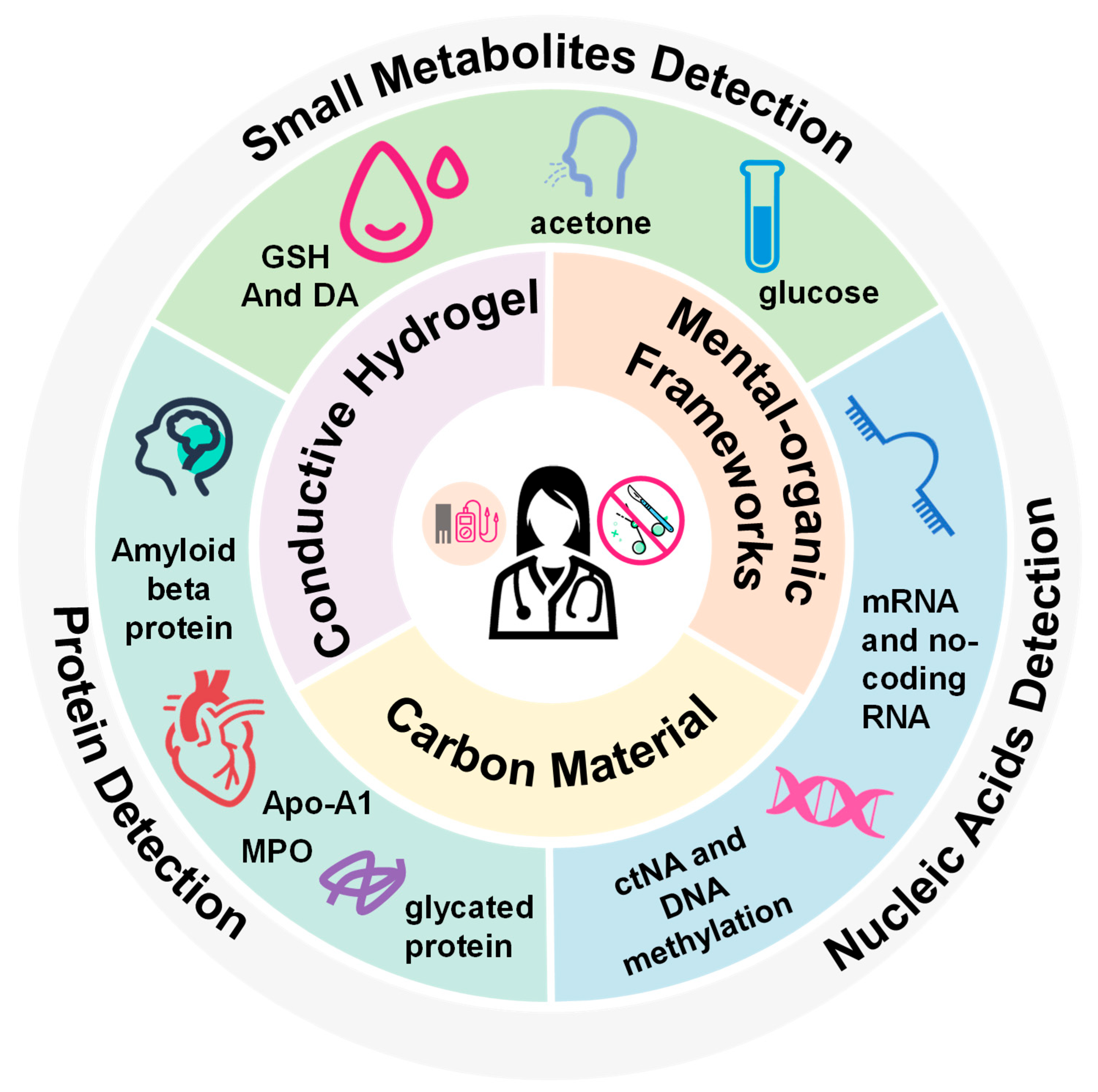
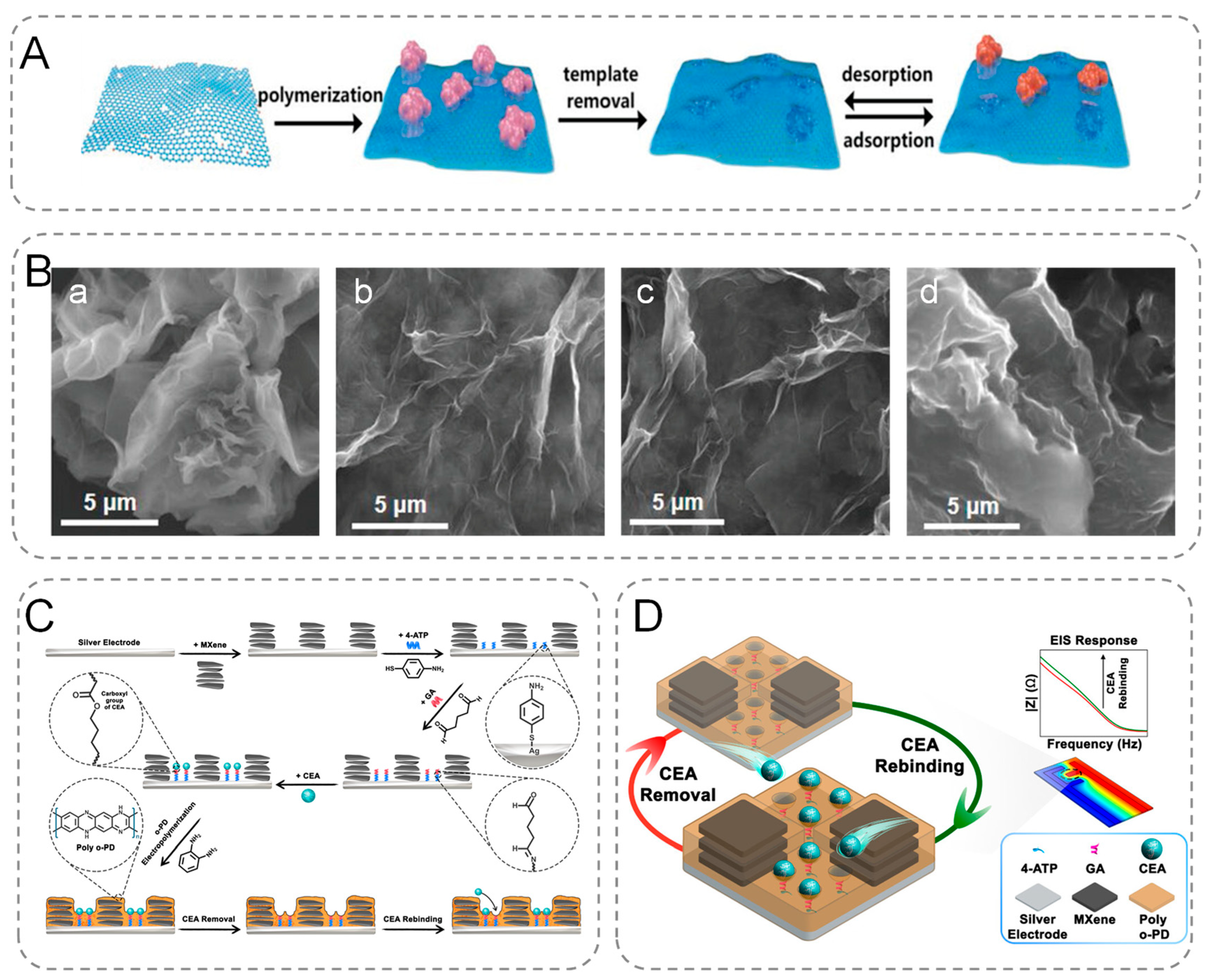
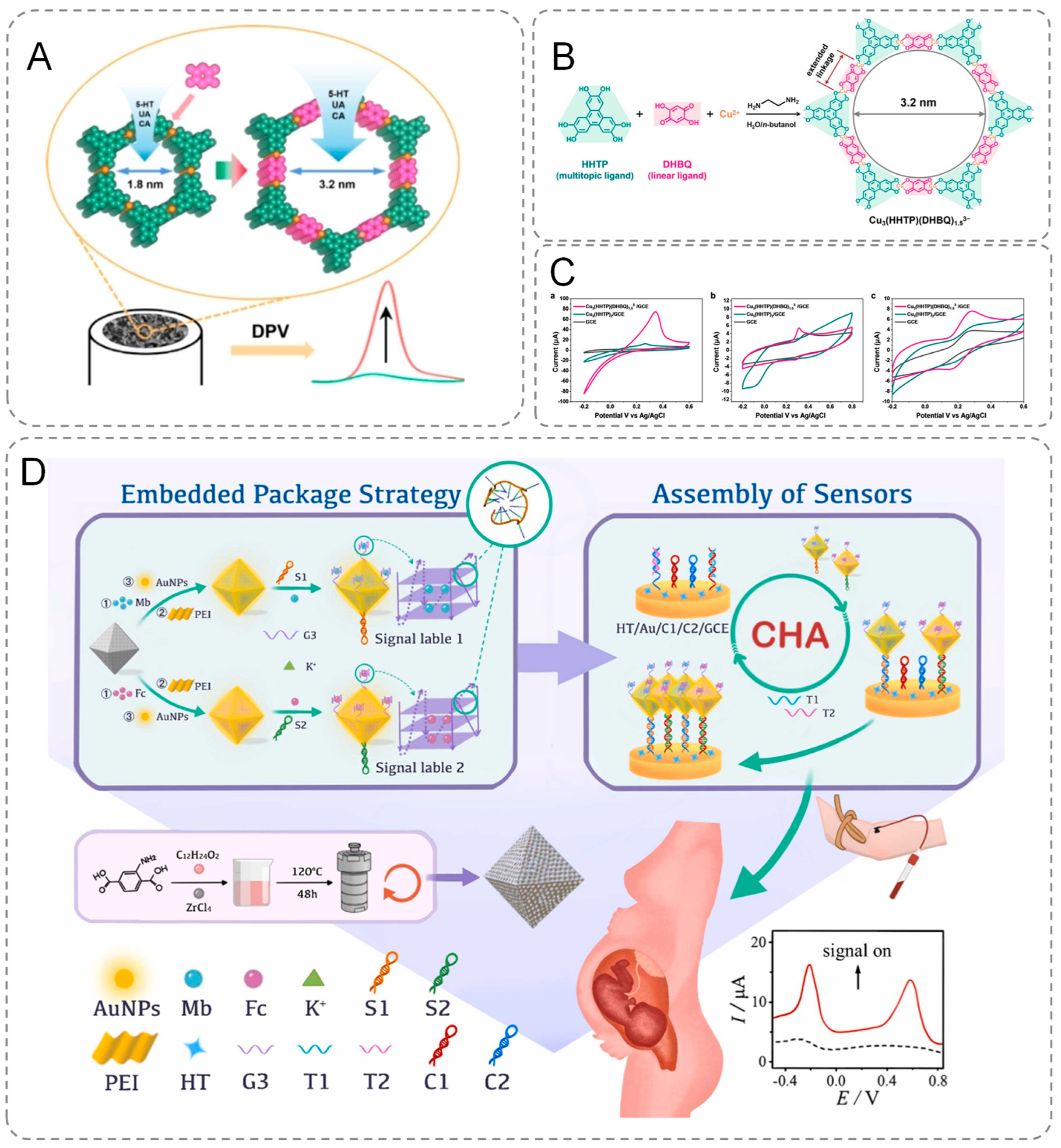
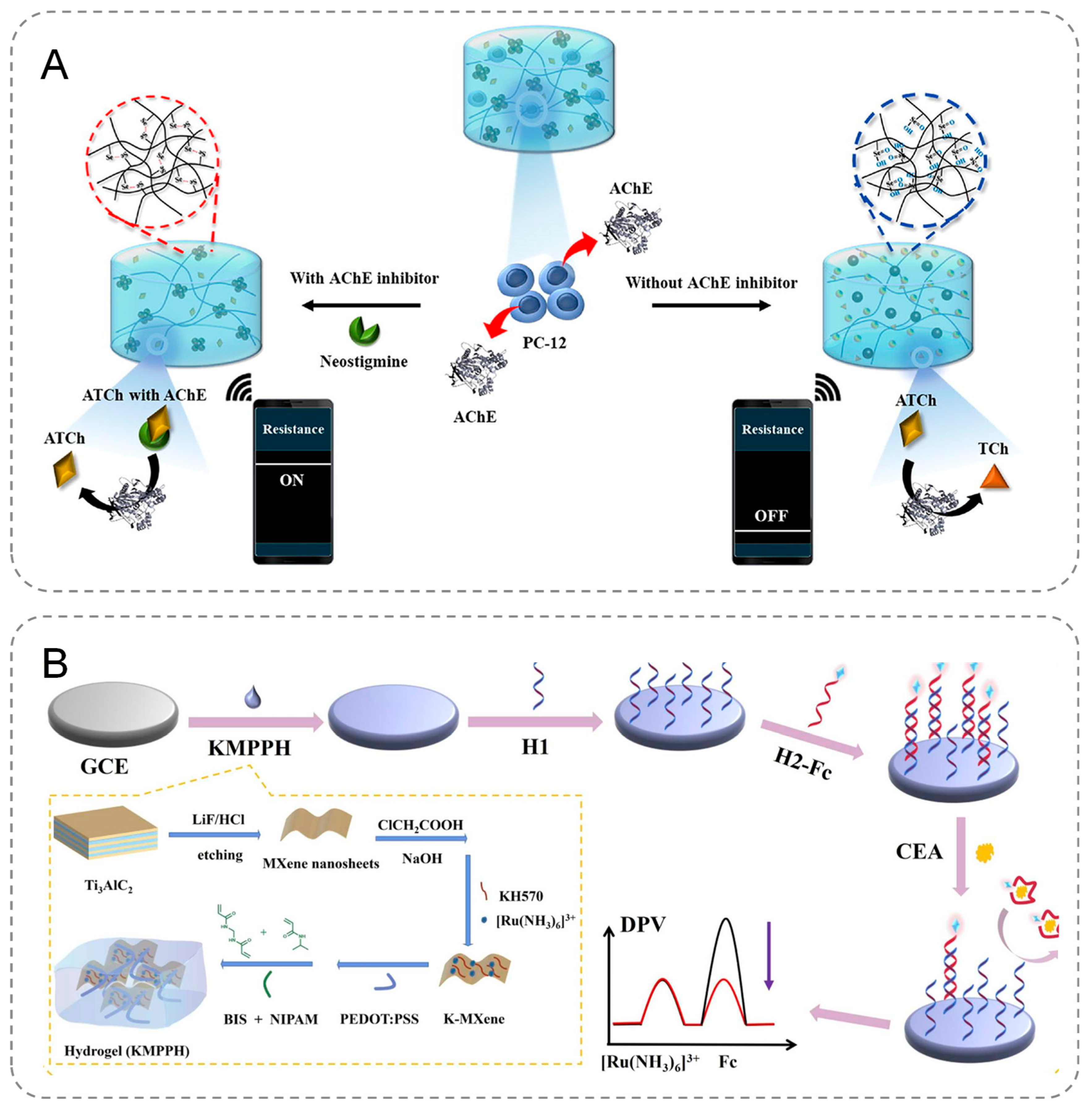
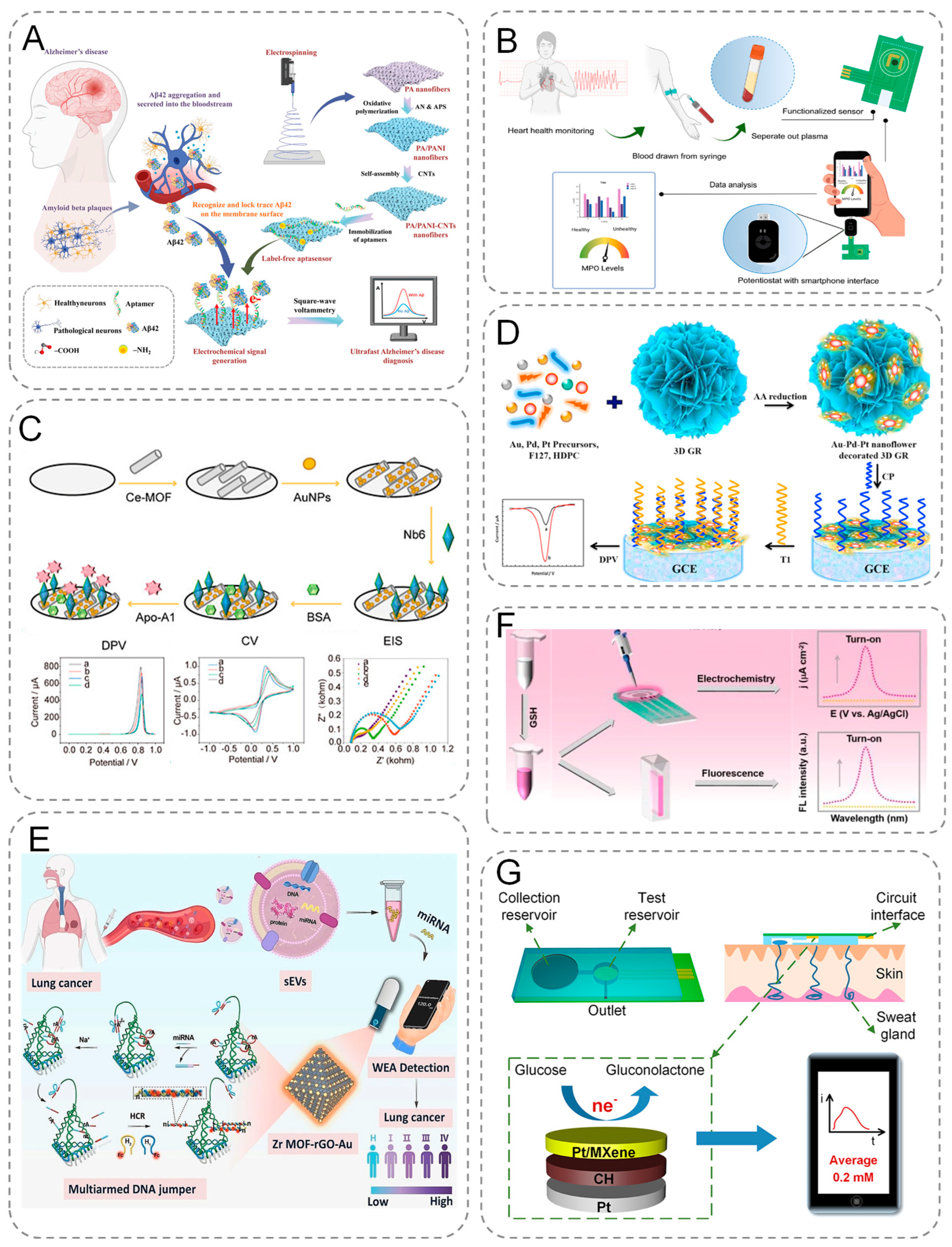
| Sensor Category | Advantages | Limitations |
|---|---|---|
| SERS biosensors | Simple fabrication (scalable); Label-free detection | Substrate interference degrades SERS signals; Specificity limited by probe design; Nanoparticle alignment affects reproducibility [9] |
| SPR biosensors | Real-time label-free detection; Nanoscale surface sensitivity | Nonspecific binding reduces sensitivity; Bulky SPR systems limit POC use [10] |
| Fluorescence biosensors | Sensitivity [11] | Nonspecific binding induces false-positive signals; Cross-fluorescence interference reduces target specificity |
| Colorimetric biosensors | User-friendly operation; Cost-effective; Biofluid compatibility [11] | Narrow linear dynamic range; Limited detection sensitivity; Limited quantitative accuracy |
| Photoelectrochemical biosensors | Outstanding sensitivity; fast measurement capability; cost-effectiveness | High instrumental complexity; Suboptimal biocompatibility [12] |
| Electrochemiluminescence-based biosensors | High versatility; Wide dynamic range; Superior reproducibility; | Limited long-term stability; Biocompatibility constraints [13] |
Disclaimer/Publisher’s Note: The statements, opinions and data contained in all publications are solely those of the individual author(s) and contributor(s) and not of MDPI and/or the editor(s). MDPI and/or the editor(s) disclaim responsibility for any injury to people or property resulting from any ideas, methods, instructions or products referred to in the content. |
© 2025 by the authors. Licensee MDPI, Basel, Switzerland. This article is an open access article distributed under the terms and conditions of the Creative Commons Attribution (CC BY) license (https://creativecommons.org/licenses/by/4.0/).
Share and Cite
Lin, J.; Chen, Y.; Liu, X.; Jiang, H.; Wang, X. Engineered Intelligent Electrochemical Biosensors for Portable Point-of-Care Diagnostics. Chemosensors 2025, 13, 146. https://doi.org/10.3390/chemosensors13040146
Lin J, Chen Y, Liu X, Jiang H, Wang X. Engineered Intelligent Electrochemical Biosensors for Portable Point-of-Care Diagnostics. Chemosensors. 2025; 13(4):146. https://doi.org/10.3390/chemosensors13040146
Chicago/Turabian StyleLin, Jiamin, Yuanyuan Chen, Xiaohui Liu, Hui Jiang, and Xuemei Wang. 2025. "Engineered Intelligent Electrochemical Biosensors for Portable Point-of-Care Diagnostics" Chemosensors 13, no. 4: 146. https://doi.org/10.3390/chemosensors13040146
APA StyleLin, J., Chen, Y., Liu, X., Jiang, H., & Wang, X. (2025). Engineered Intelligent Electrochemical Biosensors for Portable Point-of-Care Diagnostics. Chemosensors, 13(4), 146. https://doi.org/10.3390/chemosensors13040146







